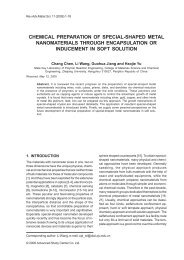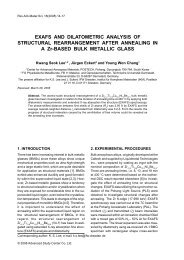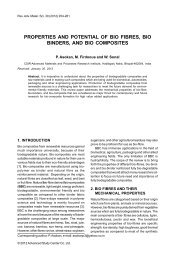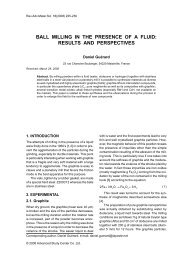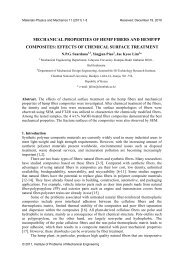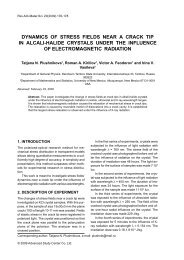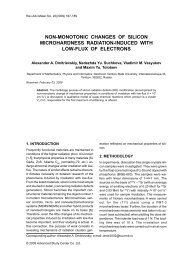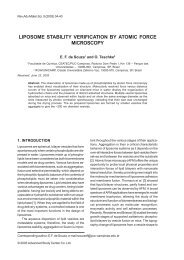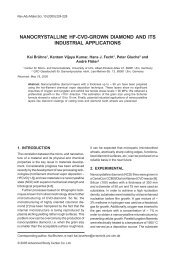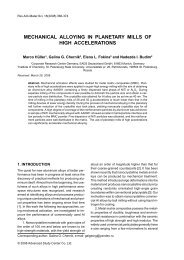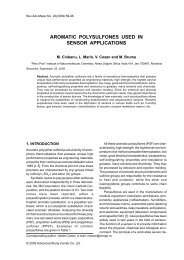surface pretreatment by phosphate conversion coatings – a review
surface pretreatment by phosphate conversion coatings – a review
surface pretreatment by phosphate conversion coatings – a review
Create successful ePaper yourself
Turn your PDF publications into a flip-book with our unique Google optimized e-Paper software.
140 T.S.N. Sankara Narayanan<br />
for the removal of rust and mill scale [175]. Dilute<br />
solutions (5-10% <strong>by</strong> weight) of H 2 SO 4 and HCl are<br />
used in presence of inhibitors to remove the inorganic<br />
contaminants <strong>by</strong> converting them into their<br />
ferrous salts. Pickling in H 2 SO 4 is usually performed<br />
at high temperatures (about 60 °C). H 3 PO 4 is an<br />
excellent time-tested cleaning agent which not only<br />
removes organic and inorganic solids present on<br />
the metal but also causes chemical etching of the<br />
<strong>surface</strong> <strong>by</strong> reacting with it to produce a mechanically<br />
and chemically receptive <strong>surface</strong> for subsequent<br />
coating formation [176].<br />
Electrolytic pickling is an alternative to chemical<br />
pickling, which provides better and rapid cleaning<br />
through an increased hydrogen evolution, resulting<br />
in greater agitation and blasting action [174].<br />
3.5.2. Rinsing<br />
The rinsing step followed <strong>by</strong> cleaning plays a vital<br />
role in the phosphating sequence [172]. Rinsing<br />
prevents the dragout of chemicals used in the earlier<br />
cleaning that may contaminate the subsequent<br />
stages.<br />
3.5.3. Phosphating<br />
Suitably cleaned <strong>surface</strong>s are next subjected to<br />
phosphating, which causes the formation of an insoluble,<br />
corrosion resistant <strong>phosphate</strong> layer on the<br />
substrate <strong>surface</strong>. A wide variety of phosphating<br />
compositions are available. However, the right choice<br />
of the components and the operating conditions of<br />
the phosphating bath are made based on the nature<br />
of the material to be treated and its end use.<br />
All the phosphating compositions are essentially<br />
dilute phosphoric acid based solutions containing<br />
alkali metal/heavy metal ions in them besides suitable<br />
accelerators [18,19,24,127,128]. Based on the<br />
nature of the metal ion constituting the major component<br />
of the phosphating solution, these compositions<br />
are classified as zinc, manganese and iron<br />
phosphating baths. The characteristics of the <strong>coatings</strong><br />
obtained using these baths are presented in<br />
Table 5.<br />
Phosphating can be effectively performed on both<br />
ferrous and non-ferrous metals. Among the ferrous<br />
metals, mild steels are most frequently used although<br />
maraging steels, galvanized steels and stainless<br />
steels can also be coated [177-180]. Non-ferrous<br />
metals that can be <strong>phosphate</strong>d include zinc,<br />
aluminium, magnesium and cadmium [181-183].<br />
Physical properties like hardness, tensile strength<br />
and workability of the original metal are retained af-<br />
ter phosphating [21]. The dimensional change<br />
caused <strong>by</strong> <strong>phosphate</strong> <strong>coatings</strong> on the metal <strong>surface</strong><br />
is of the order of 10 -3 mm.<br />
Phosphate deposition can be achieved through<br />
the use of both spray and immersion processes and<br />
the choice of the appropriate method depends upon<br />
the size and shape of the substrate to be coated<br />
and based on the end use for which the coating is<br />
made. Spray process is preferred where shorter processing<br />
times are required. This method, however,<br />
requires more factory floor space and special equipment<br />
for their application. Immersion process though<br />
slower, produce uniform <strong>coatings</strong> and they require<br />
less factory floor space as the process tanks can<br />
be arranged in a compact manner. The benefits of<br />
phosphating <strong>by</strong> total immersion were considered <strong>by</strong><br />
Wyvill [184]. But, immersion processes are more<br />
susceptible to contamination during continuous<br />
operation than are spray processes. Smaller parts<br />
can be effectively and economically <strong>phosphate</strong>d <strong>by</strong><br />
immersion process whereas spray process is more<br />
suitable for larger work pieces. Nowadays, a combination<br />
of both spray and immersion process has<br />
been successfully used particularly in automobile<br />
industries [185].<br />
Phosphating may be carried out at temperatures<br />
ranging from 30-99 °C and processing time can be<br />
varied from a few seconds to several minutes. Suitable<br />
choice of these parameters is determined <strong>by</strong><br />
factors such as nature of the metal to be coated,<br />
thickness and weight of the coating required and<br />
bath composition. The process of phosphating involves<br />
a consistent depletion of bath constituents<br />
and in order to obtain a satisfactory <strong>phosphate</strong> coating,<br />
the bath parameters such as: (i) the free acid<br />
value (FA) which refers to the free H + ions present in<br />
the phosphating solution; (ii) total acid value (TA)<br />
which represents the total <strong>phosphate</strong> content of the<br />
phosphating solution; (iii) the ratio of FA to TA, expressed<br />
as the acid coefficient; (iv) accelerator content;<br />
(v) iron content; and (vi) other metallic and nonmetallic<br />
constituents present, have to be strictly<br />
controlled within the optimum limits.<br />
3.5.4. Rinsing after phosphating<br />
The <strong>surface</strong> that has been subjected to phosphating<br />
should be thoroughly rinsed with deionized water<br />
to remove any acid residue, soluble salts and<br />
non-adherent particles present on it which would<br />
otherwise promote blistering of paint films used for<br />
finishing. Generally overflow rinsing and spray rinsing<br />
are preferred [186].



